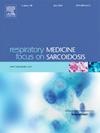Benralizumab治疗严重嗜酸性哮喘:来自t rkiye的真实数据
IF 3.1
3区 医学
Q2 CARDIAC & CARDIOVASCULAR SYSTEMS
引用次数: 0
摘要
benralizumab是一种靶向IL-5α受体的单克隆抗体,已被批准用于治疗严重嗜酸性哮喘(SEA)。尽管在随机对照试验中证明了疗效,但实际数据仍然有限。本研究旨在评估benralizumab在现实生活中的有效性。方法对接受贝纳利珠单抗治疗的SEA患者进行多中心、双向、观察性研究。临床评估包括哮喘控制测试(ACT)评分、肺功能测试、血嗜酸性粒细胞计数、口服皮质类固醇(OCS)使用、临床显著加重(CSE)、哮喘生活质量问卷(AQLQ)和中鼻结局测试(SNOT)-22评分,分别在基线和第8周、24周和52周进行记录。在第24周和第52周末对治疗效果进行评价。结果共纳入76例SEA患者(53F/23M),平均年龄50.01±13.98岁。在第8周,ACT分数从17(5-25)上升到24(6-25),并在第24周和第52周保持稳定。第8周、第24周和第52周,CSEs发生率分别下降97.7%、94.5%和87.5%。在第24周,65名患者中有71%的人没有ocs,在第52周,25名患者中有68%的人没有ocs。平均1 s用力呼气量(FEV1)在第8周和第24周分别增加298 mL和365 mL,用力呼气流量(FEF25-75)分别增加146 mL和273 mL。血液嗜酸性粒细胞计数在第8周下降到接近零,并在第24周和第52周保持抑制。在第8周和第24周也观察到AQLQ和SNOT-22评分的改善。总有效率在第24周为89.3%,在第52周为78.2%,超级有效率分别为38.5%和39.1%。结论:benralizumab表现出显著的临床和功能改善,包括更好的哮喘控制,提高的生活质量,改善的肺功能,减少CSEs和OCS的使用,支持其在SEA中的实际疗效。本文章由计算机程序翻译,如有差异,请以英文原文为准。
Benralizumab in severe eosinophilic asthma: A real-life data from Türkiye
Background
Benralizumab, a monoclonal antibody targeting IL-5α receptors, is approved for the treatment of severe eosinophilic asthma (SEA). Despite proven efficacy in randomized controlled trials, real-life data remain limited. This study aimed to evaluate effectiveness of benralizumab in real-life settings.
Method
This multicenter, bi-directional, observational study was conducted on SEA patients receiving benralizumab. Clinical assessments including asthma control test (ACT) scores, pulmonary function tests, blood eosinophil counts, oral corticosteroid (OCS) usage, clinically significant exacerbations (CSE), Asthma Quality of Life Questionnaire (AQLQ) and the Sino-Nasal Outcome Test (SNOT)-22 scores were recorded at baseline and at weeks 8, 24, and 52. The response to treatment was also evaluated at the end of 24th and 52 nd weeks.
Results
A total of 76 SEA patients (53F/23M) with a mean age of 50.01 ± 13.98 years were enrolled. The ACT scores increased from 17 (5–25) to 24 (6–25) at week 8 and remained stable at weeks 24 and 52. The rate of CSEs decreased by 97.7 %, 94.5 %, and 87.5 % at weeks 8, 24, and 52, respectively. At week 24, 71 % of 65 patients and at week 52, 68 % of 25 patients were OCS-free. The mean forced expiratory volume in 1 s (FEV1) increased by 298 mL at week 8 and 365 mL at week 24, while forced expiratory flow (FEF25-75) improved by 146 mL and 273 mL, respectively. Blood eosinophil counts dropped to nearly zero at week 8 and remained suppressed through weeks 24 and 52. Improvements in AQLQ and SNOT-22 scores were also observed at weeks 8 and 24. The overall response rates were 89.3 % at week 24 and 78.2 % at week 52, with super-responders at 38.5 % and 39.1 %, respectively.
Conclusions
Benralizumab demonstrated significant clinical and functional improvements, including better asthma control, enhanced quality of life, improved lung function, and reductions in CSEs and OCS usage, supporting its real-life efficacy in SEA.
求助全文
通过发布文献求助,成功后即可免费获取论文全文。
去求助
来源期刊

Respiratory medicine
医学-呼吸系统
CiteScore
7.50
自引率
0.00%
发文量
199
审稿时长
38 days
期刊介绍:
Respiratory Medicine is an internationally-renowned journal devoted to the rapid publication of clinically-relevant respiratory medicine research. It combines cutting-edge original research with state-of-the-art reviews dealing with all aspects of respiratory diseases and therapeutic interventions. Topics include adult and paediatric medicine, epidemiology, immunology and cell biology, physiology, occupational disorders, and the role of allergens and pollutants.
Respiratory Medicine is increasingly the journal of choice for publication of phased trial work, commenting on effectiveness, dosage and methods of action.
 求助内容:
求助内容: 应助结果提醒方式:
应助结果提醒方式:


